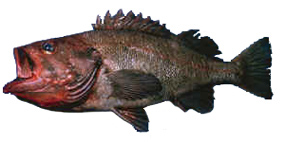

|
|
|
|
|
The rougheye rockfish (Sebastes aleutianus) are probably among the longest-lived marine fishes on Earth, living as old as 205 years. The name aleutianus refers to the Aleutian Islands, where this species was first discovered. The rougheye is also known as the blackthroat or blacktip rockfish in the fishing industry. The name rougheye refers to the 2-10 spines that are common along the lower rim of their eyes, though some have been known not to have these spines. This absence can add to the difficulty of identifying the rougheye from the shortraker rockfish, which have one or no spines. The rougheye is also identified by appearing pink, tan, or brownish with loose patches of brown or bronze when viewed underwater. A darker blotch usually appears on the rear of the operculum, and the posterior area of the lateral line is often pinkish in color. These fish are bright red or pink with black or gray patches after capture, which distinguishes them from the orange-pink or bright reddish-orange color of the shortraker. Another difference is that the rougheye has long, thin gill rakers on the first arch, while the shortraker's are short with knobby ends. These fish usually grow to 32 in. (80 cm), and have been reported as large as 38 in. (97 cm). Males and females are thought to be of similar lengths at any given age. 
The rougheye's range extends from San Diego to the Aleutian Islands
and Bering Sea to the Kamchatka Peninsula and Japan. They are found in
depths of 83 ft. to 2,416 ft. (25-2,830 m) and as deep as 9,339 ft.
(2,830 m) (providing the identification was correct when this
depth was reported as rougheyes were often confused with shortrakers and
blackgills). Common depths range between 495
ft. and 1,485 ft. (150-450 m), with larger rougheyes living deeper than
smaller ones. The rougheye live in water temperatures ranging from 31.4° F to 40.8° F
(-0.3° - 4.9° C). They are found near the sea floor around caves, crevices, and
steeply sloped boulder fields surrounded by soft substrata. Their diet
consists primarily of pandalid shrimp, while they also feed on crab,
fish, gammarid amphipods, and mysids. Adapted from Love, M. 2002 Sebastes aleutianus, p. 120-122. In M. S. Love, M. Yoklavich, and L. Thorsteinson, The rockfishes of the northeast Pacific. Univ. California Press.
|
|
|
|
|